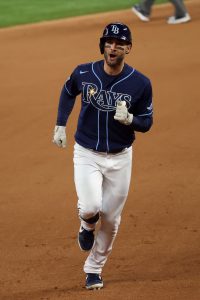The Rays were known to be in discussions with the Cubs last Friday about swinging a deal to land Kris Bryant and/or Craig Kimbrel. Ken Rosenthal and Dennis Lin of the Athletic shed some light on the talks, noting that the teams kicked around various potential frameworks — including ones worked around Tyler Glasnow or Kevin Kiermaier.
Moving Glasnow would’ve been part of a larger package deal that sent Bryant and Kimbrel to Tampa Bay, Rosenthal writes. It’d have been a fascinating development, since Glasnow’s one of the best pitchers in the league when healthy but facing a prolonged absence. The 27-year-old tossed 88 innings of 2.66 ERA/2.89 SIERA ball before suffering a UCL tear in mid-June. He’s spent the past six weeks attempting to rehab the injury, but reports from over the weekend suggest he’s likely to require Tommy John surgery, which would keep him out of action for most or all of the 2022 season.
The Rays made the Cubs aware of that possibility in discussions, Rosenthal notes; Tampa Bay wasn’t hoping to sneak Glasnow through a trade without the Cubs noticing he would probably need to go under the knife. Indeed, Glasnow’s forthcoming surgery was a significant roadblock in that kind of deal getting done.
Glasnow is under team control through 2023 via arbitration. If the right-hander were to miss the entirety of next season, the Cubs would’ve only been able to count on Glasnow for one year before he hit free agency. There’d then be real questions about how many innings he could responsibly take on in 2023 after missing nearly two years. The Rays would’ve had to include additional prospects to make that happen, and Rosenthal writes the team was unwilling to part with any of Wander Franco, Vidal Bruján, Shane Baz, Josh Lowe or Taylor Walls to do so with Bryant reaching free agency a few months from now.
The Kiermaier talks were a little more straightforward, as Rosenthal notes those discussions didn’t involve Kimbrel at all. Kiermaier’s inclusion in any sort of Bryant deal would’ve been to offset salary. (Bryant is playing out the season on a $19.5MM contract, while Kiermaier is making $11.5MM this year and has a $12MM guarantee for 2022, along with a $2.5MM buyout on a 2023 club option). In that instance as well, the Rays would obviously have had to send prospects along with Kiermaier to land Bryant.
Ultimately, the Rays didn’t wind up with either player, as the Cubs moved them in separate deals. Chicago sent Bryant to San Francisco for prospects Alexander Canario and Caleb Kilian, while Kimbrel landed with the White Sox for second baseman Nick Madrigal and reliever Codi Heuer. In Madrigal, the Cubs did land an injured big leaguer but he’s expected to be ready by the start of the 2022 season and comes with three more years of team control than does Glasnow.
Since the Cubs – Rays talks didn’t come to fruition, the Rays’ openness to discuss notable players on the big league roster is more of an interesting footnote than anything else. It does, however, speak to the possibility of Tampa Bay exploring something similar this offseason.
Glasnow is making $4MM this season, and his high-quality first half should land him a decent raise in arbitration this winter. His 2022 salary will probably end up somewhere between $6-8MM; even if he doesn’t pitch next season, he’d make the same amount in 2023. That’s still likely to appeal to many teams given Glasnow’s talent, but it’s a fairly sizable chunk of the Rays’ payroll, which typically lands between $60MM and $80MM. It’s not inconceivable the Rays could look to market Glasnow this offseason to a bigger-spending club, freeing up payroll space and either addressing a deficiency elsewhere on the big league team or recouping prospect talent while opening a 40-man roster spot.
That’s an entirely speculative scenario, to be clear; Rosenthal doesn’t suggest Tampa Bay is actively looking to trade Glasnow or feels obligated to shed salary over the offseason. But his involvement in discussions this summer — regardless of how far those talks actually progressed — serves as another reminder of the Rays’ (and teams’ generally) willingness to consider seemingly off-the-wall possibilities as part of a broader effort to set the organization up in both the present and future.
